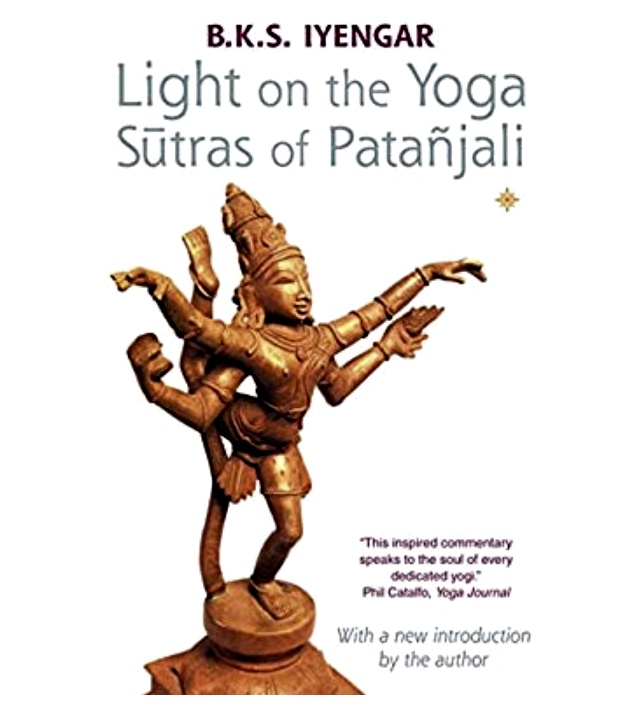Unpacking Patañjali: Sutras 1.33 for Beginners
Yoga Connections
To unpack the full scope of meaning behind any of the 196 Sutras (197 depending on translations) written almost 2,000 years ago is laughable. We always hear, “yoga is experiential” for a reason. Every serious practitioner knows whatever commentary we attempt on any aspect of yoga is in direct proportion to our personal experience. What I write here are my interpretations as I understand them at this point in my journey.
If you are an IYNAUS Member, I highly recommend Yoga Sutra sessions "Learning the Yoga Sutras with Clarity and Rigour" at RIMYI, Pune. It is conducted by Srineet Sridharan with insights from Prashant Iyengar (BKS Iyengar’s son) for students of the Institute. Srineet Sridharan is BKS Iyengar’s grandson. His lessons, coupled with insights from Prashant make for an extraordinary course.
BKS Iyengar in Light On Life explains that our thoughts and consciousness are part of every aspect of our life. When we understand their inner workings and apply right perception, the clarity and wisdom that results open us to mental and psychological freedom. In the yoga world, there are five sheaths of the body known as Kosas. Most of the “monkey mind” happens in the manomaya kosa or mental body, and the discriminating wisdom can be found in the vijnanamay kosa, the intellectual body.
BKS Iyengar lessons, as I understand them, bring awareness to the inner workings of our mind by exploring the 8-limbed path of yoga as guided by the Sutras of Patañjali through each kosa of the body. I believe he felt we can not understand or harmonize our mind stuff without synthesis and integration of the kosas in our body. Sutras 1.30-1.32 outline the nine obstacles and other distractions that cause turbulence within us. Sutras 1.33 - 1.39 offer six different possible solutions. The first of these solutions is cultivating compassion, joy, and friendliness and is translated by BKS Iyengar as follows:
मैत्रीकरुणामुदितोपेक्षाणां सुखदुःखपुण्यापुण्यविषयाणां भावनातश्चित्तप्रसादनम् ।।1.33।। maitrīkaruṇāmuditopekṣāṇāṃ sukhaduḥkhapuṇyāpuṇyaviṣayāṇāṃ bhāvanātaścittaprasādanam Through cultivation of friendliness, compassion, joy, and indifference to pleasure and pain, virtue and vice respectively, the consciousness becomes favourably disposed, serene and benevolent.
Mr. Iyengar likens our thoughts and consciousness, citta viksepa and citta prasadana to two aspects of a river: the current and the calm. The ideas behind Sutra 1.33 cultivate calm within us as well as within our social networks. The Sutra paired with the golden keys (the external and internal ethical disciplines) described in the first and second limb of the 8-limbed path, Yama and Niyama create serenity in the manmaya kosa or mental body.
My experience with this Sutra coupled with and Niyama is that I realized from a basic level, I could apply it to others much better than I could apply it to myself. Therefore, it felt like a false application that came from a desire to please rather than a place of wholeness and integration. I wasn’t indifferent. I practiced with attachment. Prashant in his insights to Srineet Sridharan’s course on the Sutra mentions the Sukha or sweetness for being compassionate to others and how that interferes with our honest practice of it. We can also help others to our detriment. If we are ill or not truly capable then it is not a healthy or right action.
I knew I didn’t experience a sthiti, steady mind with its practice. I had conditions. I had a desire to be loved or accepted. My mentor, Kquvien DeWeese mentioned that I may over function. I knew it felt exhausting. I did too much and helped dishonestly, which made my practice impure. I recall putting away props for students in the Yoga Therapy classes at the Ramamani Iyengar Memorial Yoga Institute (RIMYI) in Pune and a Senior instructor saying, “They should return their own props.” I remember Stillwater owner, Kathleen Pringle telling me the same thing in her Yoga Therapy classes in Atlanta. Students need to participate in their healing. What I considered being compassionate in this case, wasn’t.
At the institute that year, I had the honor of taking classes with Geeta Iyengar, who put a strong emphasis on commitment to our personal practice. If we are always being told what to do and how to do it, how can we hear the lessons of our soul? The deeper our practice becomes, the better we can share from a place of true understanding. Yes, our teachers are invaluable, but taking time to embody those lessons is vital to the path.
The Iyengar Method of teaching Yoga has a way of shedding light to the core of your being. I studied another method consistently for 10 years, and have been a dedicated practitioner of Iyengar for almost a decade. It takes time to slough off old habits and embody its teachings. Growing up with a parent with narcissistic tendencies, and the “jump, how high” mentality of the dance world for 23 years, my whole point of being centered around pleasing others to avoid the pain of disapproval and criticism.
I had to take time away from the voices of others so I could experience the voice within me. I got in the car and drove cross country by myself. Practicing in the woods, by rivers, in housesits, and on the sides of mountains. I began to listen. On the outside I could make the shapes of poses and appear to the novice to be aligned, but I wasn’t aligned with my inner teacher. I began with very basic asana and pranayama practice. I examined my habits, the parts of my body that I could perceive, and those areas that were dark to me.
Where did I lack compassion, joy, and friendliness? Where did I habitually think and move through a pose? What did I ignore and avoid? How did the pain/pleasure and vice/virtue dualities interfere with my repose and sthiti or steadiness? Was I already overdoing? Over thinking? How well could I adhere to the ‘twin pillers’ of abhyasa and vairagya (practice and detachment) and allow a desireless but present state to foster compassion, joy, and friendliness within me and out of me towards my external network with more authenticity?
When I started making training videos for students, I got some answers to my questions in the form of more lessons I didn’t anticipate. I had to watch and accept myself, along with my teaching, while continuing to refine with detachment, growing intelligence, and wisdom. I began to understand Sutra 1.33 and its companion limbs in a way I never expected. I took the time to pause in whatever pain, discomfort, lack of joy, compassion, and friendliness I encountered to wait for truth to come.
On the mat and off, it is an ongoing process. The deeper I go into my obstacles, the more they teach me how to overcome them. I am witnessing healing. A balance of truth is developing. I’m noticing a significant shift and purification in my behavior towards myself and others. I’ve got a long way to go, but grateful I have a path and teachers further along willing to share their understanding of it.










